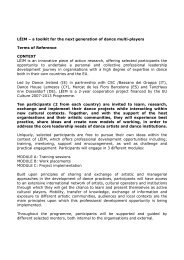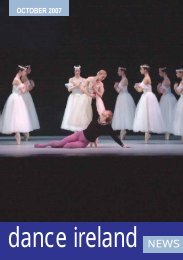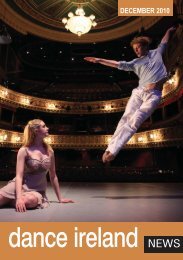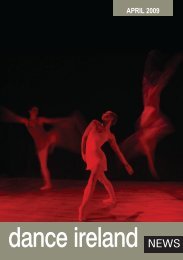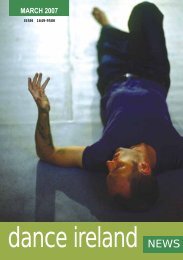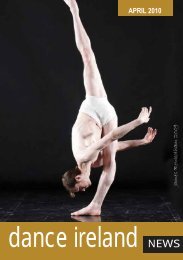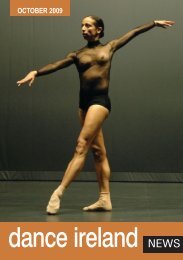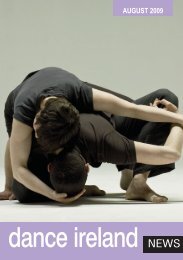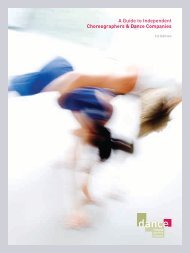April 2007 - Dance Ireland
April 2007 - Dance Ireland
April 2007 - Dance Ireland
You also want an ePaper? Increase the reach of your titles
YUMPU automatically turns print PDFs into web optimized ePapers that Google loves.
Would you say that there’s a philosophy or avision behind what you are doing, or has onearisen out of working with each other as coartisticdirectors?It’s a very interesting question about thephilosophy. I suppose a certain amount of thephilosophy comes from the fact that the dancershave done three years intensive dance training,and in Dublin it’s difficult to make the transitionfrom student to professional dancer, so it’s goodfrom their point of view that they would have anopportunity to do some kind of work withprofessional choreographers. I think, from theartistic side, I would say it’s actually a philosophythat we haven’t defined just yet and probablyis something that we will need tofind and hone.And as regards theperformance itself –can you describethat a little?Eachchoreographeris working witha twentyminute slot, butI have dividedmy 20 minutesinto two smallerpieces, [so] I’mgoing to do twopieces aroundabout 8 to 10minutes. We will have10 dancers and not all ofthem will be in each of the20 minute slots.The first idea I had really was music byDebussy, some piano preludes, which I love for thefreedom and breadth that’s in the music.The pieceis called Ashes and it’s to do with the idea that aftersomething seems to be dead or gone there can bea kind of life. And the other piece is one - thatcame quite quickly in terms of the idea - calledMusica Mundana. It’s based on the idea that earlymedieval music theory divided music into threekinds; musica mundana (music ordering thecosmos); musica humana (music ordering theperson) and finally musica instrumentalis, that ofmusical instruments. I’ve chosen a piece ofbaroque music, which is not in keeping withmedieval times but it is a very strong, very rigidpiece; it doesn’t progress very much but for mewhat works is that it keeps a structure in place.Mariam’s piece is called What If and is to do withthe idea of questioning the effects of technology,particularly on dance, and what is happening indance with regard to technology. Mairéad’s pieceuses a lovely quote from the Little Book of SufiWisdom: Rise above the world and be to yourselfyour own little world. Her pieces tend to be quiteinfluenced by the East, and tend to have a certainZen-like and beautiful quality to them. She has avery definite style at the moment. I’m not sayingeverything comes from there but inher pieces I have noticed atendency to exhibit a senseof lines or columns ofdancers that flow andit’s done in such aCore <strong>Dance</strong> Companyway that it’salmost likewatching water.It’s very specificand verybeautiful andher piecestend to get[to] a kind of astate or moodrather thanbeing narrativebased.11After this, what’snext for Core?Well, in a sense this is a trialrun, our first time doing it. It willcontinue on from here. Mairéad andmyself will sit down and re-evaluate [it] andprobably the Core <strong>Dance</strong> Company will be writteninto the module, so it will become an official partof the academic three year course. I think we’dlook to find other choreographers that we couldinvite in. We would love to have a fully fledgeddance company, with all the resources andfunding...but very much the philosophy of Marion[Lennon] is that we walk before we can run andfind out what it is we’re doing before we speak toomuch about it.Photo: Eoghan O’Reilly


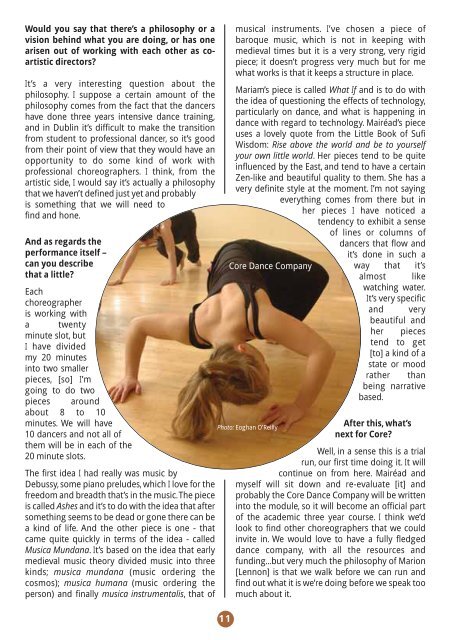
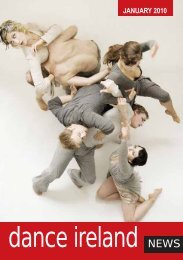
![CDs catalogue [pdf] - Dance Ireland](https://img.yumpu.com/48854475/1/190x146/cds-catalogue-pdf-dance-ireland.jpg?quality=85)
